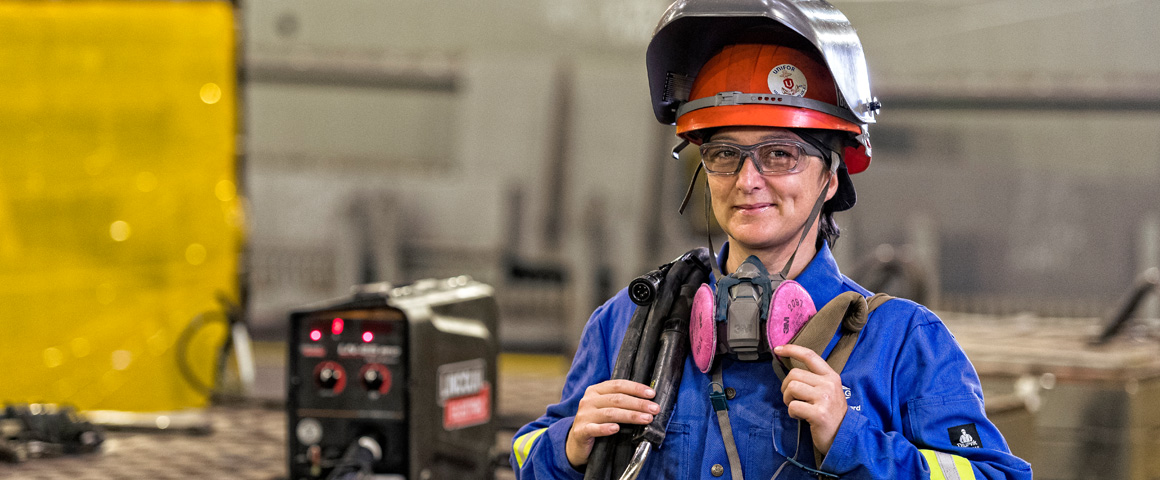Forty years ago, the percentage of women in the building trades in Canada was 3%. Today, after hundreds of millions of dollars in investments in recruitment strategies, apprenticeship program assistance, and many other initiatives from provincial and federal governments, the percentage of women in the building trades is – 3%. One of the main reasons, especially in the construction trades, is that construction workplaces are one of the last bastions of male chauvinism.
At a recent meeting of Sisters in the Trades, a peer support group for women in the building trades in the Toronto region, women agreed that the biggest barrier is the attitude of many brothers in the workplace. In many workplaces, brothers have the freedom to be as crude as they want to be. Management, again especially in the construction industry, has little training in human resource management, people skills and/or training in human rights legislation.
Some recruitment strategies have been working – the average rate of recruitment of women in the trades is 15%. Recently the BC government provided $7 million to refit classrooms in Kamloops and the Royal Bank gave $200,000 to CLAC (a company union not in the house of labour). In response to these programs, the number of women rose. However, most of those women recruited into the trades are no sooner hired than they quit. Not all the reasons are due to the hostile or toxic workplace; other issues include the lack of affordable childcare that matches the hours of work demanded in the trades.
The conditions in trades workplaces are not conducive to building an inclusive workplace. Women are often overlooked for training; most contracts do not recognize seniority. Favouritism is rampant; nepotism is very common. Most women want to fly under the radar in order to do their work, get their pay and not to be labelled a ‘trouble-maker.’ As difficult it is for women to find their place in trades workplaces, the same experience extends to racialized, gay, lesbian, trans, and aboriginal workers.
Conditions in Community College training programs have improved over the years; issues of rampant sexism and misogyny have begun to be addressed. It is now not as common for electrical apprentices in training for example, to be taught resistor codes through the mnemonic “Bad Boys Rape Young Girls But Violet Goes Willingly.” However, echoes of the grossly misogynist phrase are heard regularly in today’s construction sites.
There are more support programs in colleges – enforcement of human rights legislation for example – that make it easier to address these issues there than in the workplace.
If a worker forgets his hardhat at a site, the replacement he is forced to wear, to discourage him from doing it again, is often pink with the words ‘forget-me-not’ printed clearly for all to see. The intent is humiliation. Contrast this practise with ‘Days of Pink’ held in schools and other public sector workplaces to protest against bullying.
Heather Hamilton, a manager from Thompson River University, has stated that Canada is desperate for skilled trades and the need will only grow over the next few years. Hamilton quantifies the impending skills shortage as the need for one million more skilled workers across all trades by 2020. There is already a whole generation of women who haven’t come into the trades. We cannot let the opportunity for another generation of young women to miss out on well-paid skilled trades jobs. Increasing the number of women in the skilled trades would help close the gender wage gap.
What steps can be taken to address the incredibly low percentage of women in the trades? First of all, we need to recognize that we can’t expect changes to come from the 3% who survive in their workplaces every day. We need to demand the enforcement of key legislation in all trades workplaces. We need to demand the enforcement of the Occupational Health and Safety Act which includes measures to prevent harassment and violence in the workplace.
Gender neutral language may seem like a small measure, but if regularly enforced, it would contribute to a more respectful workplace. Programs need to be developed to train male trades workers to address the chauvinist culture in the workplace. A recent project undertaken by the BC Lions of the CFL is a step in the right direction. The program trains men to be ‘more than a bystander’; trains them to confront their peers to address violence-against-women talk in the locker room. This project was extended to trades workplaces in BC with some success.
What could the labour movement do to address the gender gap in the building trades? The Provincial Building and Construction Trades Council of Ontario recently passed a resolution at their Convention that called for an investigation on why the retention rate of women in the trades is low. They have begun their investigation by talking to groups like the Sisters in the Trades to get input on what needs to be done. Local Labour Councils can support and encourage the leadership of trades unions to take measures to assist in developing training programs to address gender issues in workplaces. Labour Council Women’s Committees should be encouraged to connect with Sisters in the Trades groups in their region.
Resolutions at Federations of Labour and the Canadian Labour Congress conventions would put this issue on the agenda for the broader labour movement. Until these are done, activists in the labour movement should bring the issue to the attention of their local Labour Council to begin a much needed conversation about equity and access for women in the Building Trades.




